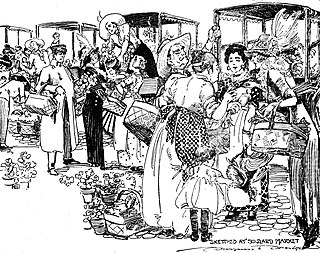Price discrimination is a microeconomic pricing strategy where identical or largely similar goods or services are sold at different prices by the same provider to different buyers based on which market segment they are perceived to be part of. Price discrimination is distinguished from product differentiation by the difference in production cost for the differently priced products involved in the latter strategy. Price discrimination essentially relies on the variation in customers' willingness to pay and in the elasticity of their demand. For price discrimination to succeed, a seller must have market power, such as a dominant market share, product uniqueness, sole pricing power, etc.

Pricing is the process whereby a business sets the price at which it will sell its products and services and may be part of the business's marketing plan. In setting prices, the business will take into account the price at which it could acquire the goods, the manufacturing cost, the marketplace, competition, market condition, brand, and quality of the product.
Discounts and allowances are reductions to a basic price of goods or services.
The subscription business model is a business model in which a customer must pay a recurring price at regular intervals for access to a product or service. The model was pioneered by publishers of books and periodicals in the 17th century, and is now used by many businesses, websites and even pharmaceutical companies in partnership with governments.

Name your own price (NYOP) is a pricing strategy under which buyers make a suggestion for a product’s price and the transaction occurs only if a seller accepts this quoted price. What happens is that the seller waits for a potential buyer's offer and can then either accept or reject that 'named price' that the user had offered. As the Internet is continuously being developed and online marketplaces are becoming increasingly more popular, consumers have more choices in terms of product pricing. Popularized by the reverse auction pioneer, Priceline.com, such pricing strategy asks consumers to 'name their own price' for various products and services like air tickets, hotels, rental cars, etc. The first bid a consumer places and the subsequent bid increments express the consumer's willingness or unwillingness to haggle. "The economic argument is that the number of bids a consumer submits to win a product in a NYOP auction is determined by the bidder’s intention to trade off higher expected savings from haggling against the associated frictional costs". NYOP retailers do not post a price for their products, and the final price of the transaction is only determined via a "reverse auction process", and these are key features that distinguish hotels and travel intermediaries from NYOP retailers. Similarly, LetYouKnow, Inc. pioneered the application of its own patented matching method within confines of the reverse auction process, whereby consumers name their own price for new vehicles.

Panera Bread is an American chain of bakery-café fast casual restaurants with over 2,000 locations, all of which are in the United States and Canada. Its headquarters are in Sunset Hills, Missouri. The chain operates as Saint Louis Bread Company in the Greater St. Louis area, where it has over 100 locations.
Sliding scale fees are variable prices for products, services, or taxes based on a customer's ability to pay. Such fees are thereby reduced for those who have lower incomes, or alternatively, less money to spare after their personal expenses, regardless of income. Sliding scale fees are a form of price discrimination or differential pricing.
In marketing, a rebate is a form of buying discount and is an amount paid by way of reduction, return, or refund that is paid retrospectively. It is a type of sales promotion that marketers use primarily as incentives or supplements to product sales. Rebates are also used as a means of enticing price-sensitive consumers into purchasing a product. The mail-in rebate (MIR) is the most common. An MIR entitles the buyer to mail in a coupon, receipt, and barcode in order to receive a check for a particular amount, depending on the particular product, time, and often place of purchase. Rebates are offered by either the retailer or the product manufacturer. Large stores often work in conjunction with manufacturers, usually requiring two or sometimes three separate rebates for each item, and sometimes are valid only at a single store. Rebate forms and special receipts are sometimes printed by the cash register at time of purchase on a separate receipt or available online for download. In some cases, the rebate may be available immediately, in which case it is referred to as an instant rebate. Some rebate programs offer several payout options to consumers, including a paper check, a prepaid card that can be spent immediately without a trip to the bank, or even as a PayPal payout.

A business can use a variety of pricing strategies when selling a product or service. To determine the most effective pricing strategy for a company, senior executives need to first identify the company's pricing position, pricing segment, pricing capability and their competitive pricing reaction strategy. Pricing strategies and tactics vary from company to company, and also differ across countries, cultures, industries and over time, with the maturing of industries and markets and changes in wider economic conditions.

Once the strategic plan is in place, retail managers turn to the more managerial aspects of planning. A retail mix is devised for the purpose of coordinating day-to-day tactical decisions. The retail marketing mix typically consists of six broad decision layers including product decisions, place decisions, promotion, price, personnel and presentation. The retail mix is loosely based on the marketing mix, but has been expanded and modified in line with the unique needs of the retail context. A number of scholars have argued for an expanded marketing, mix with the inclusion of two new Ps, namely, Personnel and Presentation since these contribute to the customer's unique retail experience and are the principal basis for retail differentiation. Yet other scholars argue that the Retail Format should be included. The modified retail marketing mix that is most commonly cited in textbooks is often called the 6 Ps of retailing.

Dynamic pricing, also referred to as surge pricing, demand pricing, or time-based pricing, and variable pricing, is a revenue management pricing strategy in which businesses set flexible prices for products or services based on current market demands. It usually entails raising prices during periods of peak demand and lowering prices during periods of low demand.
Value-based price, also called value-optimized pricing or charging what the market will bear, is a market-driven pricing strategy which sets the price of a good or service according to its perceived or estimated value. The value that a consumer gives to a good or service, can then be defined as their willingness to pay for it or the amount of time and resources they would be willing to give up for it. For example, a painting may be priced at a higher cost than the price of a canvas and paints. If set using the value-based approach, its price will reflect factors such as age, cultural significance, and, most importantly, how much benefit the buyer is deriving. Owning an original Dalí or Picasso painting elevates the self-esteem of the buyer and hence elevates the perceived benefits of ownership.
A touchpoint can be defined as any way consumers can interact with a business organization, whether person-to-person, through a website, an app or any form of communication. When consumers connect with these touchpoints they can consider their perceptions of the business and form an opinion.
The intention economy is an approach to viewing markets and economies focusing on buyers as a scarce commodity. Customers' intention to buy drives the production of goods to meet their specific needs. It is also the title of Doc Searls book: The Intention Economy: When Customers Take Charge published in May, 2012.
Customerization is the customization of products or services through personal interaction between a company and its customers. A company is customerized when it is able to establish a dialogue with individual customers and respond by customizing its products, services, and messages on a one-to-one basis. CUSTOMERization means identifying and serving what you perceive as your optimal customers. Customerization requires a company to shift its marketing model from seller-oriented to buyer-oriented. The goal is to help customers better identify what they want. Customerization enables companies to have the ability to adapt personalization and one-to-one marketing initiatives for the digital marketing environment. Customerization uses a “build-to-order” mass customization process to deliver a product or service that fits the needs of the customer. It is a critical aspect of the emerging new marketing paradigm.
In marketing, a company’s value proposition is the full mix of benefits or economic value which it promises to deliver to the current and future customers who will buy their products and/or services. It is part of a company's overall marketing strategy which differentiates its brand and fully positions it in the market. A value proposition can apply to an entire organization, parts thereof, customer accounts, or products and services.

In the retail industry, a buyer is an individual who selects what items are stocked and their key responsibility is dealing with all the products that come into the store. Buyers usually work closely with designers and their designated sales representatives and attend trade fairs, wholesale showrooms and fashion shows to observe trends. They are employed by large department stores, chain stores or smaller boutiques. For smaller independent stores, a buyer may participate in sales as well as promotion, whereas in a major fashion store there may be different levels of seniority such as trainee buyers, assistant buyers, senior buyers and buying managers, and buying directors. Decisions about what to stock can greatly affect fashion businesses.
Customer to customer markets provide a way to allow customers to interact with each other. Traditional markets require business to customer relationships, in which a customer goes to the business in order to purchase a product or service. In customer to customer markets, the business facilitates an environment where customers can sell goods or services to each other. Other types of markets include business to business (B2B) and business to customer (B2C).
Pay what you want is a pricing strategy where buyers pay their desired amount for a given commodity. This amount can sometimes include zero. A minimum (floor) price may be set, and/or a suggested price may be indicated as guidance for the buyer. The buyer can select an amount higher or lower than the standard price for the commodity. Many common PWYW models set the price prior to a purchase, but some defer price-setting until after the experience of consumption. PWYW is a buyer-centered form of participative pricing, also referred to as co-pricing.

Pink Peacock was a café and infoshop in the Govanhill area of Glasgow. Described by its founders as "anti-Zionist" and "the only queer Yiddish anarchist vegan pay-what-you-can café in the world", it opened physically in 2021, after being delayed by the COVID-19 pandemic, and announced its closure in June 2023.







